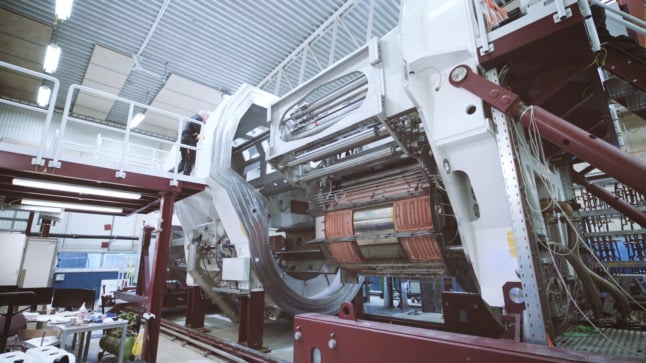‘Slowbalisation’: why Swedish companies are moving back home
Sweden has a dynamic, modern economy, led by Stockholm’s status as an international innovation and startup hub. But you may be surprised to learn that a growing number of Swedish companies with production bases overseas are choosing to move these operations home.

Experts say the trend is part of the process of ‘slowbalisation’ and can even be seen in services, as well as manufacturing.
So, what are the reasons for the change and what does it mean for the Stockholm region, the jobs market and the Swedish economy as a whole? The Local spoke to Joacim Tåg, of the Stockholm-based Research Institute of Industrial Economics (IFN), and the CEO of one company that has taken the leap, to find out.
Reasons for reversing
Costs, increasing automation, sustainability, and intellectual property are all drivers for Swedish companies to give up producing abroad, says Tåg. “I think a lot of companies have reversed their decisions after realising they made mistakes along the way,” he says.
One reason for this is that rising labour costs in China and other Asian economies may mean what made economic sense a decade or so ago doesn’t look so sound now. “Big macroeconomic shocks like the Covid-19 crisis also provide an opportunity for companies to look over their operations and try to cut costs,” adds Tåg.
Furthermore, increasing automation makes labour costs a less critical factor for many firms. “That means you don’t need to produce in these countries any more, many of which have more unstable institutional environments that are not well-suited to large investments in automation and factories,” he says. Some companies may also be motivated by the ability to better protect their intellectual property by moving production home, he adds.
ChromoGenics, which makes high performance energy-efficient glass, decided to move its main production facility from the US back to Sweden after sourcing advanced technical equipment from a company in Germany that had gone bankrupt.
In April this year, production began at its new plant in Uppsala, where seven permanent new skilled jobs have been created. In total, the move may have created work for 20 to 25 people, including a pool of students from Uppsala University, according to the company’s CEO, Leif Ljungqvist. He says there are no disadvantages of producing in Sweden.
“The reasons for moving home were to have better quality control over the production process and also that the transportation costs were quite high,” Ljungqvist explains. “Sustainability is obviously also a factor.”
How highly-skilled workers win
Both the true extent of the trend and its overall impact could be much better understood. That’s why Tåg is starting a research project that will analyse which jobs continue to disappear abroad and which are coming back to Sweden.
“It’s a net positive when production moves back home,” he says. “However, the jobs you get back are not the same jobs you lost when you offshored to get cheap labour in China. Typically, when you’re investing in a high-tech factory in Sweden, it’s more highly-skilled jobs that are created and the low-skilled jobs don’t come back.”
 Joacim Tåg. Photo: Supplied
Joacim Tåg. Photo: SuppliedThe new ChromoGenics facility is “fairly automated” and only workers of “high competence” can run the machinery, says Ljungqvist. Such engineering expertise has a similar cost whether you’re recruiting in China or Sweden, he adds.
Tåg cites AI as another area where tech continues to require expert supervision rather than completely replacing human labour. “In some areas, we see shortages of tech workers because tech advances but then you need the workers that take care of the technologies,” he says.
Stockholm’s status as a startup and fintech hub – along with low interest rates and an active venture capital market – is also likely to ensure demand for highly-skilled workers remains strong in the city. “A lot of Stockholm firms are on the leading edge of technology and that leads to skill shortages,” Tåg says.
Local ‘spillover’ benefits
While the overall number of jobs being created nationally so far is modest, it’s important to understand the potential for significant local “spillover” effects.
Setting up a big production plant in Sweden has indirect as well as direct benefits; other local firms may become suppliers, for instance, and there may be opportunities for new restaurants or other services. “It can really be a win for smaller regions in Sweden,” says Tåg.
In addition to Chromogenics, another recent example is the eyewear company Synsam moving production from China to Östersund in Jämtland. The new factory is expected to open in 2022 and will create around 200 jobs.
Nor is the trend limited to manufacturing; Tåg says it encompasses “all kinds of industries” in Sweden. Some IT and legal services jobs that moved to the Balkans, for example, are also starting to come home.
Slowbalisation not deglobalisation
Some economists have talked about globalisation changing to an era of ‘slowbalisation’ since the 2008 financial crisis. Tåg, director of IFN’s Firm Competitiveness research programme, says the “immense growth in globalisation” that was dominant in recent decades is over. But he adds: “There’s a deceleration of globalisation but it’s not going into reverse.”
He estimates that between two and five percent of Swedish firms that took production abroad have moved it home or are doing so. While more companies continue to offshore operations than move home at present, Tåg says he does expect the homecoming trend to continue.
Ljungqvist believes it’s becoming more attractive to many mid-sized and smaller Swedish companies as a result of Covid-19. “People will look to have better control over their supply chain and other things,” says the CEO. “The pandemic hadn’t started when the decision was taken. But now we feel quite lucky as we have other contractors that have been affected by Covid.”
Looking ahead, he predicts: “With really high volume production, it might still be worth going to China. But with mid-sized and smaller volumes, I think production will be coming back to Sweden.”
This content was paid for by an advertiser and produced by The Local's Creative Studio.


Join the conversation in our comments section below. Share your own views and experience and if you have a question or suggestion for our journalists then email us at [email protected].
Please keep comments civil, constructive and on topic – and make sure to read our terms of use before getting involved.
Please log in here to leave a comment.